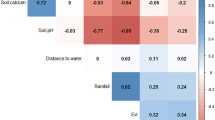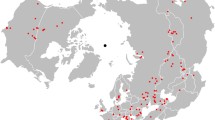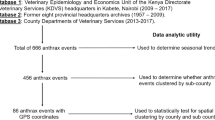Abstract
Cases of anthrax in livestock are infrequently and irregularly reported in the state of Victoria, Australia; however, their impact on individual livestock, farming communities and the government agencies tasked with containing these outbreaks is high. This infrequency has been anecdotally associated with differences in annual and local weather patterns. In this study, we used historical anthrax cases and meteorological data from weather stations throughout Victoria to train a generalized linear mixed effects model to predict the daily odds of a case of anthrax occurring in each shire in the coming 30 days. Meteorological variables were transformed to deviations from the mean values for temperature or cumulative values for rainfall in the shire across all years. Shire was incorporated as a random effect to account for meteorological variation between shires. The model incorporated a post hoc weighting for the frequency of historic cases within each shire and the spatial contribution of each shire to the recently redefined Australian Anthrax Belt. Our model reveals that anthrax cases were associated with drier summer conditions (OR 0.96 (95% CI 0.95–0.97) and OR 0.98 (95% CI 0.97–0.99) for every mm increase in rainfall during September and December, respectively) and cooler than average spring (OR 0.20 (95% CI 0.11–0.52) for every °C increase in minimum daily temperature during November and warmer than average summer temperatures (OR 1.45 (95% CI 1.29–1.61) for every °C increase in maximum daily temperature during January. Cases were also preceded by a 40-day period of cooler, drier temperatures (OR 0.5 (95% CI 0.27–0.74) for every °C increase in maximum daily temperature and OR 0.96 (95% CI 0.95–0.97) for every mm increase in rainfall followed by a warmer than average minimum (or nightly) temperature 10 days immediately before the case (OR 1.46 (95% CI 1.35–1.58) for every °C increase in maximum daily temperature). These coefficients of this training model were then applied daily to meteorological data for each shire, and output of these models was presented as a choropleth and timeline plot in a Shiny web application. The application builds on previous spatial modelling and provides Victorian agencies with a tool to engage at-risk farmers and guide discussions towards anthrax control. This application can contribute to the wider rejuvenation of anthrax knowledge and control in Victoria and corroborates the anecdote that increased odds of disease can be linked to meteorological events.





Similar content being viewed by others
References
Barro AS, Fegan M, Moloney B, Porter K, Muller J, Warner S, Blackburn JK (2016) Redefining the Australian Anthrax Belt: modeling the ecological niche and predicting the geographic distribution of bacillus anthracis. PLoS Negl Trop Dis 10(6):e0004689. https://doi.org/10.1371/journal.pntd.0004689
Bennett C (1975) Up hierarchy. Journal of extension 13 (MAR-A):7-12
Blackburn JK, Goodin DG (2013) Differentiation of springtime vegetation indices associated with summer Anthrax epizootics in West Texas, USA, deer. J Wildl Dis 49(3):699–703. https://doi.org/10.7589/2012-10-253
Brownlie TS, Holmes I, Delahunty H, Salmon S, Hunnam JC (2019) Perceptions of anthrax in livestock from Victorian dairy farmers in the Goulburn-Murray region of Victoria, Australia. Aust Vet J. https://doi.org/10.1111/avj.12844
Chang W, Cheng J, Allaire J, Xie Y, McPherson J (2017) Shiny: web application framework for R. R package version 1.0.3. Edn.
De Vos A, Cumming GS, Cumming DHM, Ament JM, Baum J, Clements HS, Grewar JD, Maciejewski K, Moore C (2016) Pathogens, disease, and the social-ecological resilience of protected areas. Ecol Soc 21 (1). doi:https://doi.org/10.5751/es-07984-210120
Fasanella A, Galante D, Garofolo G, Jones MH (2010) Anthrax undervalued zoonosis. Vet Microbiol 140(3–4):318–331. https://doi.org/10.1016/j.vetmic.2009.08.016
Hugh-Jones ME, de Vos V (2002) Anthrax and wildlife. Revue Scientifique Et Technique De L Office International Des Epizooties 21 (2):359–383
Jubb TF (2007) A review of anthrax in Victoria 2007. Department of Primary Industries, Victoria
Mock M, Fouet A (2001) Anthrax. Annu Rev Microbiol 55:647–671. https://doi.org/10.1146/annurev.micro.55.1.647
Pepe MS, Cai TX, Longton G (2006) Combining predictors for classification using the area under the receiver operating characteristic curve. Biometrics 62(1):221–229. https://doi.org/10.1111/j.1541-0420.2005.00420.x
Porter K, Macfarlane-Berry L, Mohammad I, Warner S, Wilks C, Firestone S, Fegan M (2016) Serological surveillance for anthrax in healthy Victorian cattle. Epidemiological Chapter Proceedings of the Science Week Scientific Meeting of the Australian and New Zealand College of Veterinary Scientists
R Core Team (2017) R: A language and environment for statistical computing
Turnbull PCB (2002) Introduction: anthrax history, disease and ecology. Anthrax 271:1–19
Turner AJ, Galvin JW, Rubira RJ, Miller GT (1999) Anthrax explodes in an Australian summer. J Appl Microbiol 87(2):196–199. https://doi.org/10.1046/j.1365-2672.1999.00869.x
Wang YJ, Chen HH, Li RZ, Duan NH, Lewis-Fernandez R (2011) Prediction-based structured variable selection through the receiver operating characteristic curves. Biometrics 67(3):896–905. https://doi.org/10.1111/j.1541-0420.2010.01533.x
Funding
This study was funded by Agriculture Victoria, Department of Economic Development, Jobs, Transport and Resources, Attwood, Victoria, Australia.
Author information
Authors and Affiliations
Corresponding author
Ethics declarations
Conflict of interest
The authors declare that they have no conflict of interest.
Rights and permissions
About this article
Cite this article
Brownlie, T., Bishop, T., Parry, M. et al. Predicting the periodic risk of anthrax in livestock in Victoria, Australia, using meteorological data. Int J Biometeorol 64, 601–610 (2020). https://doi.org/10.1007/s00484-019-01849-0
Received:
Revised:
Accepted:
Published:
Issue Date:
DOI: https://doi.org/10.1007/s00484-019-01849-0




